Researchers develop winged robot that can land like a bird
Japanese Robot Manufacturer relies on Digital Twin by CENIT
12 years of NCCR Robotics
After 12 years of activity, NCCR Robotics officially ended on 30 November 2022.
We can proudly say that NCCR Robotics has had a truly transformational effect on the national robotics research landscape, creating novel synergies, strengthening key areas, and adding a unique signature that made Switzerland prominent and attractive at the international level.
In its 12 years of activity, NCCR Robotics has had a transformational effect on the national robotics research landscape.
Our highlights include:
- Achieving several breakthroughs in wearable, rescue and educational robotics
- Creating new master’s and doctoral programmes that will train generations of future robotics engineers
- Graduating more than 200 PhD students and 100 postdocs, with more than 1’000 peer-reviewed publications
- Spinning out several projects into companies, many of which have become international leaders and generated more than 400 jobs
- Improving awareness of gender balance in robotics and substantially increasing the percentage of women in robotics in Switzerland
- Kick-starting large outreach programs, such as Cybathlon, Swiss Drone Days, and Swiss Robotics Days, which will continue to increase public awareness of robotics for good
It is not the end of the story though: our partner institutions – EPFL, ETH Zurich, the University of Zurich, the University of Bern, the University of Basel, Università della Svizzera Italiana, EMPA – will continue to collaborate through the Innovation Booster Robotics, a new national program aimed at developing technology transfer activities and maintaining the network.
Research
The research programme of NCCR Robotics has been articulated around three Grand Challenges for future intelligent robots that can improve the quality of life: Wearable Robotics, Rescue Robotics, and Educational Robotics.
In the Wearable Robotics Grand Challenge, NCCR Robotics studied and developed a large range of novel prosthetic and orthotic robots, implantable sensors, and artificial intelligence algorithms to restore the capabilities of persons with disabilities and neurological disorders.
For example, researchers developed implantable and assistive technologies that allowed patients with completely paralyzed legs to walk again thanks to a combination of assistive robots (such as Rysen), implantable microdevices that read brain signals and stimulate spinal cord nerves, and artificial intelligence that translate neural signals into gait patterns.
They also developed prosthetic hands with soft sensors and implantable neural stimulators that enable people to feel again the haptic qualities of objects. Along this line, they also studied and developed prototypes of an extra arm and artificial intelligence that could allow humans to control the additional artificial limb in combination with their natural arms for situations that normally require more than one person.
Researchers also developed the MyoSuit textile soft exoskeletons that allow persons on wheelchairs to stand up, take a few steps, and then sit back on the wheelchair without external help.
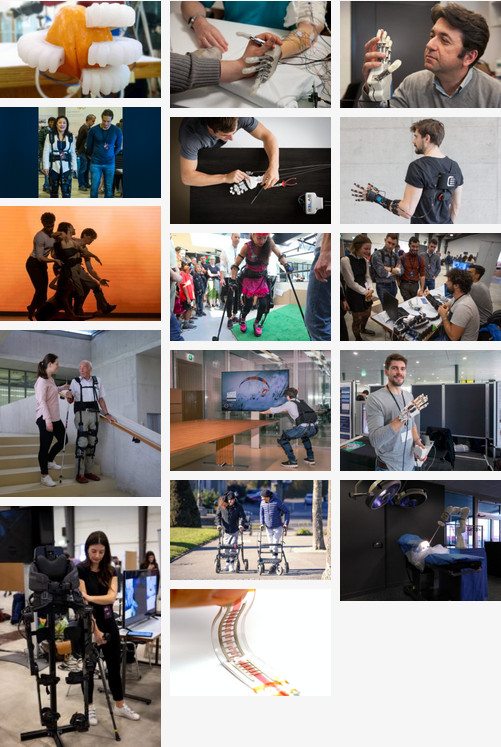
In the Rescue Robotics Grand Challenge, researchers developed and deployed legged and flying robots with self-learning capabilities for use in disaster mitigation as well as in civil and industrial inspection.
Among the most notable results are ANYMal, a quadruped robot that won the first prize in the international DARPA challenge, by exploring underground tunnels and identifying a number of objects; K-rock, an amphibious robot inspired by salamanders and crocodiles that can swim, walk, and squat under narrow passages; a collision-resilient drone that has become the most widely used robot in the world by rescue teams, governments, and companies for inspection of confined spaces, bridges, boilers, and ship tankers, to mention a few; a whole family of foldable drones that can change shape to squeeze through narrow passage, protect nearby persons from propellers, carry cargo of various size and weight, and twist their arms to get close to surfaces and perform repair operations; an avian-inspired drone with artificial feathers that can approximate the flight agility of birds of prey.
In addition, researchers developed powerful learning algorithms that enabled legged robots to walk up mountains and grassy land by adapting their gait, and flying robots that learn to fly and avoid high-speed moving objects using bio-inspired vision systems, and even learned to race through a circuit beating world-champion humans. Researchers also proposed new methods to let inexperienced humans and rescue officers interact with, and easily control, drones as if they were an extension of their own body.
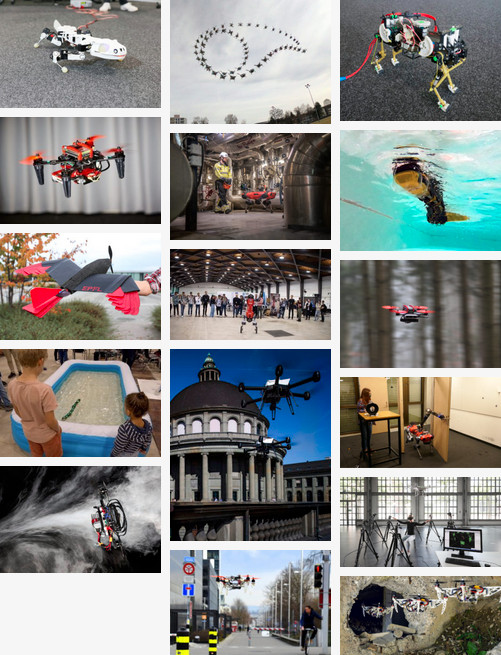
In the Educational Robotics Grand Challenge, NCCR researchers created Thymio, a mobile robot for teaching programming and elements of robotics that has been deployed in more than 80’000 units in classrooms across Switzerland, and Cellulo, a smaller modular robot that allows richer forms of interaction with pupils, as wells as a broad range of learning activities (physics, mathematics, geography, games) and training methods for teaching teachers how to integrate robots in their lectures.
Researchers also teamed with Canton Vaud on a large-scale project to introduce robotics and computer science into all primary-school classes and have already trained more than one thousand teachers.
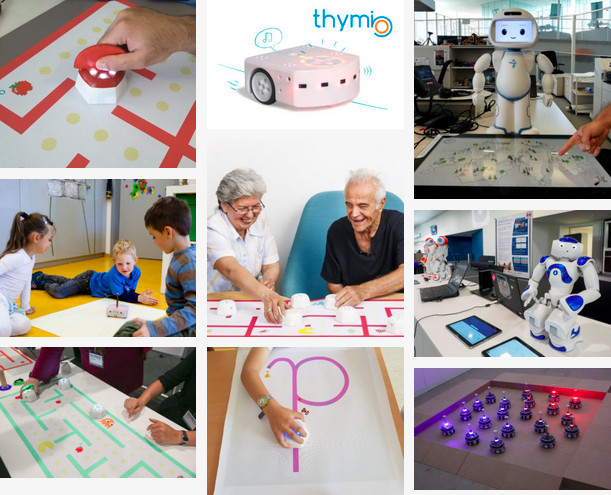
Outreach
Communication, knowledge (and technology) transfer to society and the economy
Over 12 years, NCCR Robotics researchers published approximately 500 articles in peer-review journals and 500 articles in peer-reviewed conferences and filed approximately 50 patents (one third of which have already been granted). They also developed a tech-transfer support programme to help young researchers translate research results into commercially viable products. As a result, 16 spin-offs were supported, out of which 14 have been incorporated and are still active. Some of these start-ups have become full scale-up companies with products sold all over the world, have raised more than five times capital than the total funds of the NCCR over 12 years, and generated several hundreds of new high-tech jobs in Switzerland.
Several initiatives were aimed at the public to communicate the importance of robotics for the quality of life.
- For example, during the first phase NCCR Robotics organized an annual Robotics Festival at EPFL that attracted at its peak 17’000 visitors in one day.
- In the second phase, Cybathlon was launched, a world-first Olympic-style competition for athletes with disabilities and supported by assistive devices, which was later taken over by ETH Zurich that will ensure its continuation.
- Additionally, NCCR Robotics launched the Swiss Drone Days at EPFL that combine drone exhibitions, drone races, and public presentations, and were later taken over by EPFL and most recently by University of Zurich.
- NCCR Robotics also organized the annual Swiss Robotics Day with the aim of bringing together researchers and industry representatives in a full day of high-profile technology presentations from top Swiss and international speakers, demonstrations of research prototypes and robotics products, carousel of pitch presentations by young spin-offs, and several panel discussions and networking events.

Promotion of young scientists and of academic careers of women
The NCCR Robotics helped develop a new master’s programme and a new PhD programme in robotics at EPFL, created exchange programmes and fellowships with ETH Zurich and top international universities with a program in robotics, and issued several awards for excellence in study, research, technology transfer, and societal impact.
NCCR Robotics has also been very active in addressing equal opportunities. Activities aimed at improving gender balance included dedicated exchange and travel grants, awards for supporting career development, master study fellowships, outreach campaigns, promotional movies and surveys for continuous assessment of the effectiveness of actions. As a result, the percentage of women in the EPFL robotics masters almost doubled in four years, and the number of women postgraduate and assistant professors doubled too. Although much remains to be done in Switzerland, the initial results of these actions are promising and the awareness of the importance of equal opportunity has become pervasive throughout the NCCR Robotics community and in all its research, outreach, and educational activities.
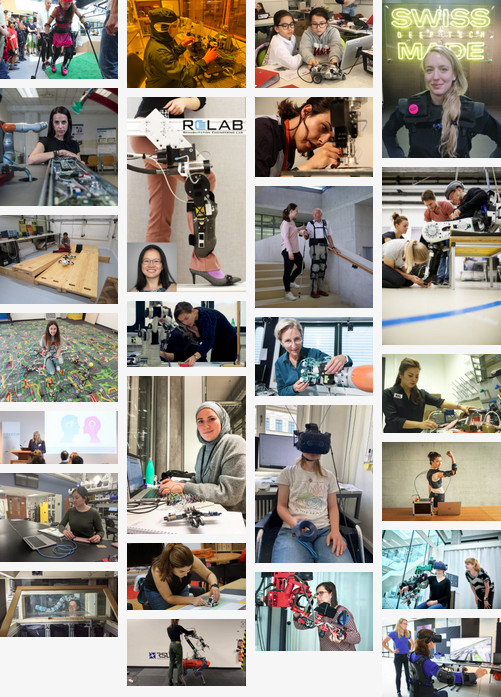
Beyond NCCR Robotics
In order to sustain the long-term impact of NCCR Robotics, EPFL launched a new Center of Intelligent Systems where robotics is a major research pillar and ETH Zurich created a Center for Robotics that includes large research facilities, annual summer schools, and activities to favor collaborations with industry.
Furthermore, EPFL built on NCCR Robotics’ educational technologies and further programmes to create the LEARN Center that will continue training teachers in the use of robots and digital technologies in schools. Similarly, ETH Zurich built on the research and competence developed in the Wearable Robotics Grand Challenge to create the Competence Centre for Rehabilitation Engineering and Science with the goal of restoring and maintaining independence, productivity, and quality of life for people with physical disabilities and contribute towards an inclusive society.
As the project approaches its conclusion, NCCR Robotics members applied for additional funding for the National Thematic Network Innovation Booster Robotics that was launched in 2022 and will continue supporting networking activities and technology transfer in medical and mobile robotics for the next 4 years. Finally, a Swiss Robotics Association comprising stakeholders from academia and industry will be created in order to manage the Innovation Booster programme and offer a communication and collaboration platform for the transformed and enlarged robotics community that NCCR Robotics has contributed to create.
Robot plant grows, wilts on fate of UN nature talks
MARM, the new three-legged robot to transport weights and manipulate components in space
Look over there: A robot delivers food to an Uber Eats’ customer in Miami
Can robots care? – Coreless motors driving patient care robots
Soft robots gain new strength and make virtual reality gloves feel more real
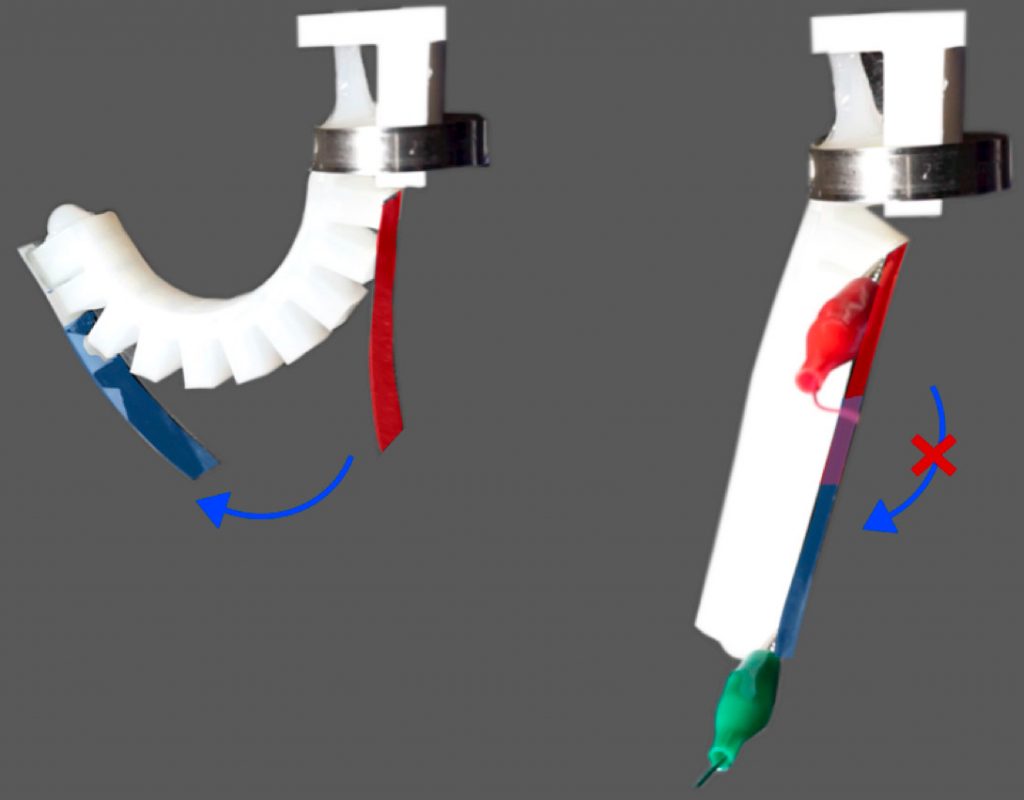
Soft robots, or those made with materials like rubber, gels and cloth, have advantages over their harder, heavier counterparts, especially when it comes to tasks that require direct human interaction. Robots that could safely and gently help people with limited mobility grocery shop, prepare meals, get dressed, or even walk would undoubtedly be life-changing.
However, soft robots currently lack the strength needed to perform these sorts of tasks. This long-standing challenge — making soft robots stronger without compromising their ability to gently interact with their environment — has limited the development of these devices.
With the relationship between strength and softness in mind, a team of Penn Engineers has devised a new electrostatically controlled clutch which enables a soft robotic hand to be able to hold 4 pounds – about the weight of a bag of apples – which is 40 times more than the hand could lift without the clutch. In addition, the ability to perform this task requiring both a soft touch and strength was accomplished with only 125 volts of electricity, a third of the voltage required for current clutches.
Their safe, low-power approach could also enable wearable soft robotic devices that would simulate the sensation of holding a physical object in augmented- and virtual-reality environments.
James Pikul, Assistant Professor in Mechanical Engineering and Applied Mechanics (MEAM), Kevin Turner, Professor and Chair of MEAM with a secondary appointment in Materials Science Engineering, and their Ph.D. students, David Levine, Gokulanand Iyer and Daelan Roosa, published a study in Science Robotics describing a new, fracture-mechanics-based model of electroadhesive clutches, a mechanical structure that can control the stiffness of soft robotic materials.
Using this new model, the team was able to realize a clutch 63 times stronger than current electroadhesive clutches. The model not only increased force capacity of a clutch used in their soft robots, it also decreased the voltage required to power the clutch, making soft robots stronger and safer.
Current soft robotic hands can hold small objects, such as an apple for example. Being soft, the robotic hand can delicately grasp objects of various shapes, understand the energy required to lift them, and become stiff or tense enough to pick an object up, a task similar to how we grasp and hold things in our own hands. An electroadhesive clutch is a thin device that enhances the change of stiffness in the materials which allows the robot to perform this task. The clutch, similar to a clutch in a car, is the mechanical connection between moving objects in the system. In the case of electroadhesive clutches, two electrodes coated with a dielectric material become attracted to each other when voltage is applied. The attraction between the electrodes creates a friction force at the interface that keeps the two plates from slipping past each other. The electrodes are attached to the flexible material of the robotic hand. By turning the clutch on with an electrical voltage, the electrodes stick to each other, and the robotic hand holds more weight than it could previously. Turning the clutch off allows the plates to slide past each other and the hand to relax, so the object can be released.
Traditional models of clutches are based on a simple assumption of Coulombic friction between two parallel plates, where friction keeps the two plates of the clutch from sliding past each other. However, this model does not capture how mechanical stress is nonuniformly distributed in the system, and therefore, does not predict clutch force capacity well. It is also not robust enough to be used to develop stronger clutches without using high voltages, expensive materials, or intensive manufacturing processes. A robotic hand with a clutch created using the friction model may be able to pick up an entire bag of apples, but will require high voltages which make it unsafe for human interaction.
“Our approach tackles the force capacity of clutches at the model level,” says Pikul. “And our model, the fracture-mechanics-based model, is unique. Instead of creating parallel plate clutches, we based our design on lap joints and examined where fractures might occur in these joints. The friction model assumes that the stress on the system is uniform, which is not realistic. In reality, stress is concentrated at various points, and our model helps us understand where those points are. The resulting clutch is both stronger and safer as it requires only a third of the voltage compared to traditional clutches.”
“The fracture mechanics framework and model in this work have been used for the design of bonded joints and structural components for decades,” says Turner. “What is new here is the application of this model to the design of electroadhesive clutches.”
The researchers’ improved clutch can now be easily integrated into existing devices.
“The fracture-mechanics-based model provides fundamental insight into the workings of an electroadhesive clutch, helping us understand them more than the friction model ever could,” says Pikul. “We can already use the model to improve current clutches just by making very slight changes to material geometry and thickness, and we can continue to push the limits and improve the design of future clutches with this new understanding.”
To demonstrate the strength of their clutch, the team attached it to a pneumatic finger. Without the researchers’ clutch, the finger was able to hold the weight of one apple while inflated into a curled position; with it, the finger could hold an entire bag of them.
In another demonstration, the clutch was able to increase the strength of an elbow joint to be able to support the weight of a mannequin arm at the low energy demand of 125 volts.
Future work that the team is excited to delve into includes using this new clutch model to develop wearable augmented and virtual-reality devices.
“Traditional clutches require about 300 volts, a level that can be unsafe for human interaction,” says Levine. “We want to continue to improve our clutches, making them smaller, lighter and less energetically costly to bring these products to the real world. Eventually, these clutches could be used in wearable gloves that simulate object manipulation in a VR environment.”
“Current technologies provide feedback through vibrations, but simulating physical contact with a virtual object is limited with today’s devices,” says Pikul. “Imagine having both the visual simulation and feeling of being in another environment. VR and AR could be used in training, remote working, or just simulating touch and movement for those who lack those experiences in the real world. This technology gets us closer to those possibilities.”
Improving human-robot interactions is one of the main goals of Pikul’s lab and the direct benefits that this research presents is fuel for their own research passions.
“We haven’t seen many soft robots in our world yet, and that is, in part, due to their lack of strength, but now we have one solution to that challenge,” says Levine. “This new way to design clutches might lead to applications of soft robots that we cannot imagine right now. I want to create robots that help people, make people feel good, and enhance the human experience, and this work is getting us closer to that goal. I’m really excited to see where we go next.”
Quadruped robot with magnetized feet can climb on metal buildings and structures (video)
What Are Fresnel Lenses Used For?
2nd call for robot holiday videos 2022 (with first submissions!)

That’s right! You better not run, you better not hide, you better watch out for brand new robot holiday videos on Robohub!
Drop your submissions down our chimney at daniel.carrillozapata@robohub.org and share the spirit of the season.
Here are our first two submissions of the roundup: